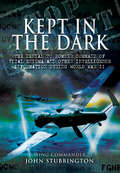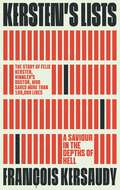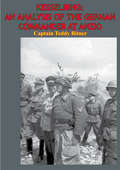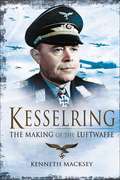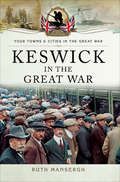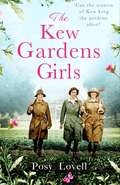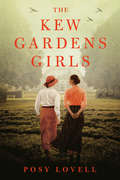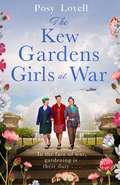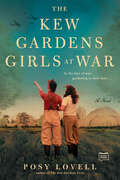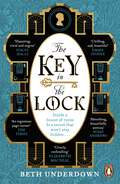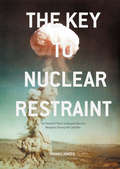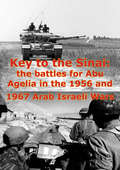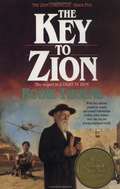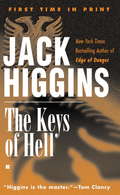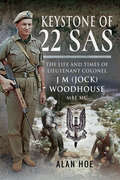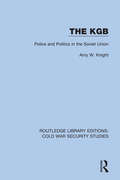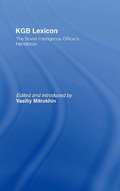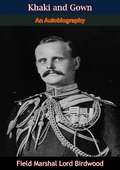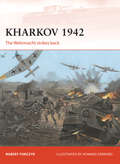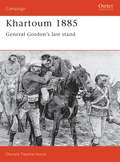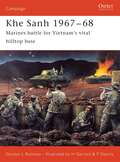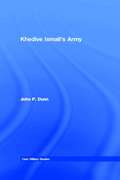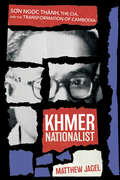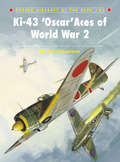- Table View
- List View
Kept in the Dark: The Denial to Bomber Command of Vital Enigma and Other Intelligence Information During World War II
by John StubbingtonThis fascinating historical revelation goes to the very heart of British and Allied Intelligence during World War II, specifically in the context of planning, control and implementation of the combined bomber offensive against Germany. There are sound arguments based on official archives that the handling of much air intelligence was faulty and reasons to believe that some departments within Whitehall were influenced by parochial and personal attitudes that interfered with the selection of strategic targets and the planning of the bombing offensives. In some departments within Whitehall and even the Air Ministry, there was a culpable failure to understand and appreciate the operational capabilities and limitations of the RAF and USAAF bomber forces. After the evacuation of the BEF the only means of destroying the Axis production of arms and munitions fell to the RAF and this was their prime objective for the rest of the war. The destruction of arms factories, power stations, air and ship production was the underlining objective, although when special targets, such as the break-outs of the German navy's major warships and U-Boats were deemed vital, the RAF were expected to react immediately. Much of Britain's intelligence was gathered from the German ENIGMA signals and became known as ULTRA with a security classification of MOST SECRET. Apart from the brilliant work at Bletchley Park there were other inputs from partisans throughout occupied Europe, Allied agents and various forms of reconnaissance. It was a new type of warfare that developed and improved as the war progressed but all too often the bomber squadrons were put into unnecessary peril through imprecise and unthinking demands from the highest levels of government.
Kersten's Lists: A Saviour in the Depths of Hell
by François KersaudyOskar Schindler is well known for having saved a thousand Jews from Nazi extermination during World War II. Yet Felix Kersten, Heinrich Himmler's personal physician, remains almost unknown to this day. Only Kersten was able to relieve the Reichsführer of his crippling and chronic abdominal pains. Though despising the Nazis, he continued to work for Himmler throughout the war, using his position to pass intelligence to Finland, Sweden and the Netherlands, and demanding as payment from Himmler the liberation of victims sentenced to imprisonment or death. Drawing on unseen archive material from Germany, Sweden, The Netherlands and Israel, François Kersaudy guides us in the footsteps of a man who exploited the politics of hatred and fear within the Third Reich to save the lives of over a hundred thousand people, including sixty thousand Jews.
Kesselring: An Analysis of The German Commander at Anzio
by Captain Teddy BitnerThis study attempts to analyze the decisions made by Field Marshal Albert Kesselring prior to and during the battle of Anzio in February 1944. The focus of the investigation is on Kesselring's decision to shift Army Group reserves from the Rome area prior to the Allied amphibious assault at Anzio on 18 January 1944, then his involvement in the development and execution of the German counterattack against the Allied beachhead conducted on 16 February 1944.The investigation reveals that Kesselring, the Army Group Commander, made a proper and effective decision in committing the Army Group reserves to the German defensive line prior to the invasion, and that his involvement in the development and execution of the German counterattack at Anzio was doctrinally sound and generally effective.
Kesselring: The Making of the Luftwaffe (Greenhill Military Paperbacks Ser.)
by Kenneth MackseyIllustrated with maps and a center section of black and white photographs. Kesselring-commander, leader, administrator; the only senior German officer to start and finish the Second World War holding a high command appointment. There was scarcely a major campaign in which he was not at some time deeply involved: he flew in the forefront of the battle over Poland, Holland, Britain, Russia and the Western Desert and was shot down five times; as a field commander he defended Tunisia, Italy and, ultimately, Germany. But it is as much for his role in the formation and development of the Luftwaffe that Kesselring is remembered-his were many of the ideas, plans and insights about the part played by aircraft in the land battle. They were central to the careful, systematic reorganization and building up of the German military machine in the 1920s and 30s. This first complete biography presents the complex, fascinating personality of a man whose qualities of utter determination, charm and good humor, harnessed to outstanding training and experience, enabled him to cope with both victory and defeat and, finally, when placed on trial for his life, to face his judges with dignity, equanimity and a staunch defense.
Keswick in the Great War (Your Towns & Cities in the Great War)
by Ruth ManserghKeswick in the Great War is an expert account of this Lake District market town's fascinating, yet largely forgotten, contribution to the Great War effort from the outbreak of war in 1914, to the long-awaited Allied victory in 1918.It charts the remarkable, and sometimes moving, stories of several heroic local figures, including Lord and Lady Rochdale, who converted their home into a VAD hospital; Caleb Barnes, a former headteacher of Braithwaite Primary School who was taken prisoner in Belgium; Catherine Elizabeth Marshall, supporter of The No-Conscription Fellowship, whose husband, the chairman of the NCF, was imprisoned in 1916; and Reverend Bettison, Curate of Crosthwaite, who was mobilised on 4 August 1914 and sent to Burma in October 1914. The book also acts as an accessible reference guide to local war memorials, such as The Fretwork War Shrine, as integrated throughout are rare wartime illustrations of these memorials and rolls of honour, like the recently discovered roll of honour found inside Underskiddaw Church Rooms.Overall, this is a poignant testimony to the momentous efforts, bravery, self-sacrifice and determination of the people of Keswick during the Great War, who sought to find normality in a reality so far removed from anything they had ever known.
The Kew Gardens Girls: An emotional and sweeping historical novel perfect for fans of Kate Morton
by Posy LovellIt's 1916 and England is at war. Desperate to help in whatever way they can, Ivy and Louisa enlist as gardeners at Kew, taking on the jobs of the men who have gone to fight. Under their care, the Gardens begin to flourish - but Ivy and Louisa aren't being treated fairly, and not everyone wants them there. Without women's rights, the pair begin to struggle - but can the support of the Suffragettes help their cause? And when a tragedy overseas affects the people closest to them, can the women of Kew pull together to support themselves and their country through the darkest of times?A heartwarming historical novel about women in wartime, inspired by real life events. Readers love The Kew Gardens Girls:'This was a wonderful book to read, three girls from different backgrounds work at Kew gardens while the men are away at war.' 5 stars
The Kew Gardens Girls
by Posy LovellA heart-warming novel inspired by real life events, about the brave women during WWI who worked in the historic grounds of London's Kew Gardens.Can the women of Kew keep the gardens alive in the midst of war?London, 1916. England is at war. Desperate to help in whatever way they can, Ivy and Louisa enlist as gardeners at Kew, the Royal Botanic Gardens, taking on the jobs of the men who have gone to fight. Under their care, the gardens begin to flourish and become a safe haven for those seeking solace--but not everyone wants women working at Kew. The pair begin to face challenges on the home front. When a tragedy overseas affects the people closest to them, can the women of Kew pull together to support themselves and their country through the darkest of times?
The Kew Gardens Girls at War: A heartwarming tale of wartime at Kew Gardens
by Posy LovellA heartwarming historical novel about women in wartime, inspired by the real-life events at Kew Gardens.When Daisy Turner's new husband joins the RAF to fight the Battle of Britain, she's terrified she's going to lose him. So when her mother Ivy suggests she joins the gardeners at Kew to keep busy, Daisy's intrigued. After all, Ivy worked at Kew during the last war and made lifelong friends along the way.Ivy's friend, Louisa Armitage, is feeling old and useless at her Kent home, wishing she could return to Kew and do her bit for the war effort. Tensions are rising between Louisa and her pacifist husband, as they argue over their nephew Christopher, who's enlisted. But Louisa's not ready to hang up her gardening gloves yet, and she's soon on her way to Kew with an idea that could really make a difference.Meanwhile Beth Sanderson is furious after her father stops her applying to medical school. Angry and frustrated, she applies to a new wartime role at Kew Gardens, alongside her doctor friend Gus Campbell. But the committee is run by men and Beth is asked to take a job a gardener instead, running a demonstration allotment with new friend Daisy. As the bombs fall on a Blitz-stricken London she finds herself torn between Gus, and her boyfriend Paul. Can Gus and Beth overcome the racism of wartime Britain to be together?When tragedy hits, the women are forced to come together to support each other through their darkest hours. But can the Kew Gardens Girls survive the horrors of war-torn London this time?
The Kew Gardens Girls at War
by Posy LovellInspired by real events, a touching novel about a new class of courageous women who worked at London&’s historic Kew Gardens during World War II.In the face of war, gardening is their duty…When Daisy Cooper&’s new husband joins the RAF to fight the Battle of Britain, she&’s terrified she&’s going to lose him. So when her mother Ivy suggests she join the gardeners at Kew to keep busy, Daisy&’s intrigued. After all, Ivy worked at Kew during the last great war and made lifelong friends along the way. Louisa Armitage, not ready to hang up her gardening gloves just yet, and Beth Sanderson, an aspiring doctor looking to make a difference, decide to enlist as well. When tragedy strikes, the women are forced to come together to support one other during their darkest hours. But can the Kew Gardens Girls survive the horrors of war-torn London this time?
The Key In The Lock: A haunting historical mystery steeped in explosive secrets and lost love
by Beth Underdown'Haunting, vivid and urgent' Stacey Halls'Absorbing, beautifully written' Rosie Andrews'An ingenious page turner' The Times--------------Inside lies a secret that won't stay hidden . . . The Great War is ending, but it has taken Ivy's son. Ivy is consumed by discovering what happened to her boy out there in the trenches, while her husband only wants to forget.Then a man comes back into Ivy's life who can help her find out. A man who once stole Ivy's heart. A man who also lost his son to a tragedy. A man whose name she hasn't spoken in thirty years.As Ivy questions her part in the fire at Polneath House, she unlocks a secret that's been burning ever since. But will the truth destroy her - or set her free?--------------'It will recruit fans of Du Maurier and Waters' Patrick Gale'A story of smouldering secrets, lingering guilt and hidden love' Daily Express'The perfect gothic novel' Stuart Turton'This is a novel of true elegance, deftly and satisfyingly plotted' Imogen Hermes Gowar'Atmospheric and rich with evocative detail' Harriet Tyce'An intriguing, elegantly constructed gothic mystery' Sunday Times'A smouldering gothic mystery that slowly envelopes you' Joseph Knox
The Key to Nuclear Restraint
by Thomas JonterWhy have some nations acquired nuclear weapons while others have refrained from doing so? Most research related to this question has focused on states that have built nuclear weapons, yet little attention has been devoted to countries that have chosen nuclear restraint. This book analyzes Swedish plans to acquire nuclear weapons during the Cold War. Sweden was very close to putting a bomb together in 1960s but, for a number of reasons illuminated in this book, decision makers abandoned those plans and subsequently rose to become one of the most recognized players in the international game of disarmament. Thanks to the recent declassification of essential documentation in Sweden and United States, it is now possible to assemble a comprehensive analysis of the Swedish nuclear weapons program based on primary sources. This book presents that analysis, a unique perspective owing to the fact that nuclear development is a highly secretive activity in most countries - with non-existent or limited access to state archives.
Key To The Sinai: The Battles For Abu Agelia In The 1956 And 1967 Arab Israeli Wars [Illustrated Edition]
by George W. Gawrych[Includes 5 figures and 21 maps]Situated between the Suez Canal and Israel and marked by the harsh environment of the central Sinai lies Abu Ageila, an unprepossessing area of low ridges and hills through which passes the best-surfaced road in the peninsula. Owing to its location on the central route, close to the Israeli-Egyptian border, Abu Ageila became the key to the Sinai in the Arab-Israeli wars of 1956 and 1967. The struggle for this barren land in two wars provides an epic story of battle and reveals the influence of experience on the preparation for and conduct of war.In both the 1956 and 1967 wars, Abu Ageila was the main gateway to the Sinai for the Israel Defense Forces. Yet, as Dr. George W. Gawrych demonstrates, there were marked differences between Egyptian and Israeli war plans, preparations, operations, and results in the two battles for the area. In 1956, Israel carried the burden of a constricting alliance with Britain and France and faced other extensive military problems. The result was that Israel fought a difficult and costly battle for Abu Ageila. In contrast, in 1967, the Israel Defense Forces developed a brilliant operational plan and achieved effective unit command and control and attained a decisive victory.Based on extensive research, including personal interviews with Israeli commanders and briefings by Egyptian military historians, Key to the Sinai is a crisp battle narrative of desert warfare and a systematic historical analysis of two armies confronting the changing terms of battle. Students of AirLand Battle doctrine will find reading this Research Survey a stimulus to meeting the challenges of modern warfare.
The Key to Zion (The Zion Chronicles, Book #5)
by Bodie Thoene Brock ThoeneBack Cover: Rabbi Lebowitz has waited a lifetime for this moment. No Jew has held the key to the Gate of Zion since AD 70. Yet on May 14, 1948, the day of Israel's statehood, the British will turn that key--the symbol of his hope for the nation--over to him. But before the British evacuate, full scale fighting breaks out. Five Middle Eastern nations gather around Palestine to divide it among themselves. Caught in the middle, the native Palestinians flee. Is there any hope for peace? for stopping the bloodshed?
The Keys of Hell
by Jack HigginsBritish expatriate Paul Chavasse is about as tough as they come. For years, he has made a dangerous living running men and intelligence across the Adriatic Sea from Italy to the communist country of Albania. But his ideals are about to be tested - more than he ever thought possible. The Albanian government, seeking to crush a religious resurgence within its borders, wants to find and destroy the Madonna of Scutari - a legendary statue of ebony and gold that has protected the faithful for a thousand years. Before government forces capture them, priests hide the carving deep in the marshes along the coast. Now, Paul Chavasse must outrun an entire army in a race to save the priceless relic - and the lives of thousands of believers.
Keystone of 22 SAS: The Life and Times of Lieutenant Colonel J. M. (Jock) Woodhouse MBE MC
by Alan HoeThis British military biography tells the full story of the Lieutenant Colonel who helped turn the 22nd SAS into the world&’s leading special forces unit. Despite its successes during World War II, the future of the British Army&’s Special Air Service was uncertain for years afterward. In the 1950s, it was resurrected as the 22nd SAS Regiment to take part in the Malayan Emergency, and over time evolved into one of the British military&’s most important units. This renaissance was brought about by a small group of highly motivated officers. Of these, Lieutenant Colonel John Woodhouse stood out for his energy, expertise, and courage. Written by an SAS insider, this biography demonstrates how Woodhouse played a pivotal role in transforming the 22nd SAS into an elite fighting force. Woodhouse led the regiment through campaigns in Oman, Borneo, Radfan and South Arabia, as it built its unrivaled reputation. After leaving the Army, Woodhouse became a sought-after counter-terrorist consultant taking an advisory and active role in operations worldwide. While Colonel Sir David Stirling publicly acknowledged Woodhouse as a cofounder of the 22nd SAS, the full story of his role has not been widely recognized. As this fascinating book reveals, without his efforts there would probably be no 22nd SAS today.
The KGB: Police and Politics in the Soviet Union (Routledge Library Editions: Cold War Security Studies #28)
by Amy W. KnightThis book, first published in 1990, examines the origins and evolution of the security police, considering the continuities as well as changes in its function as guardian of the regime’s security. It analyses the KGB’s involvement in Kremlin politics, the structure and organisation of the KGB, its formal tasks and legal prerogatives as set forth by the Party leadership, and the actual functions it performs on behalf of the Soviet regime. Underlying this analysis is an attempt to assess the power and authority of the KGB relative to other political institutions and to explain the crucial dynamics of the Party- KGB relationship.
KGB Lexicon: The Soviet Intelligence Officers Handbook
by Vasili MitrokhinIn this volume Mitrokhin presents two dictionaries produced by the KGB itself to define their activities in both offensive and defensive intelligence work. The translated documents tell the story of the KGB's methods and targets and should interest the general public as well as the specialist.
Khaki and Gown: An Autobiography
by Field Marshal Lord BirdwoodField Marshal William Riddell Birdwood, 1st Baron Birdwood, was a British Army officer. He saw active service in the Second Boer War on the staff of Lord Kitchener and action again in the First World War as Commander of the Australian and New Zealand Army Corps during the Gallipoli Campaign in 1915, leading the landings on the peninsula and then the evacuation later in the year, before becoming commander-in-chief of the Fifth Army on the Western Front during the closing stages of the war. An autobiography by an old soldier with tales of adventure from all over the world. The “gown” refers to his later years as Master of Peterhouse at Cambridge. Winston Churchill served with Lord Birdwood in the Boer War, and writes a glowing two-page foreword.
Kharkov 1942
by Robert Forczyk Howard GerrardAfter failing to finish off the German Army in the 1941/42 Winter Counteroffensive and aware that Hitler was planning a new summer offensive in mid-1942, Stalin directed the Red Army to conduct a powerful blow in one sector of the Eastern Front in order to disrupt German plans. The sector chosen was Kharkov, where the Soviet Southwestern Front had seized bridgeheads over the Donets River and Heeresgruppe Süd appeared vulnerable. Under Stalin's trusted military advisor, Marshal Semyon Timoshenko, the Stavka's remaining reserves were assembled and prepared to conduct a breakthrough attack intended to encircle the German Sixth Army near Kharkov.However, Stalin was unaware that the Germans were planning their own riposte at Kharkov, known as Operation Fredericus. When Timoshenko began his offensive in May 1942, he did not realize the limitations of his own forces or the agility of the Germans to recover from setbacks, all of which contributed to one of the Red Army greatest defeats of World War II. The German victory at Kharkov also contributed to the Wehrmacht's ability to push to the Volga River, once the Red Army was seriously weakened along the Donets. This volume will pay particular attention to intelligence and logistics issues, as well as how this campaign served as a prelude to the battle of Stalingrad. It will also focus on the nascent development of the Red Army's tank corps and 'deep battle' tactics, as well as the revival of the German Panzertruppen after Barbarossa.
Khartoum 1885
by Donald FeatherstoneOsprey's Campaign title for the Siege of Kartoum (1884-1885). Early in 1881 unrest in the Sudan began to crystallise around Mohammed Ibn Ahmed el-Sayyid Abdullah. Proclaiming himself the long-expected Madhi, the Guided One of the Prophet, he preached that the Sudan was to be purged of its Egyptian oppressors. Drawn in by the Egyptian failure to deal with the situation, the British sent General Gordon to organise an evacuation. On reaching Khartoum however, General Gordon believed, incorrectly, that the Madhi could be reasoned with. Instead of negotiating, the Madhi besieged the town for 317 days. This title looks in particular, although not exclusively, at the battles fought by the British columns sent to relieve Khartoum.
Khe Sanh 1967-68
by Gordon Rottman Peter DennisKhe Sanh was a small village in northwest South Vietnam that sat astride key North Vietnamese infiltration routes. In September 1966 of the Vietnam War (1955-1975), a Marine battalion deployed into the area. Action gradually increased as the NVA attempted to destroy Free World Forces bases, and the siege of Khe Sanh proper began in October 1967. The bitter fight lasted into July 1968 when, with the changing strategic and tactical situation, the base was finally closed. This book details the siege and explains how, although the NVA successfully overran a Special Forces camp nearby, it was unable to drive US forces from Khe Sanh.
Khedive Ismail's Army (Cass Military Studies)
by John P. DunnKhedive Ismail's Army examines military failure in the age of imperialism. On paper, the mid-nineteenth century Egyptian army seems a formidable regional power. It had a tradition of success, modern weapons, and mercenary officers with experience in major wars. Egypt's ruler, Khedive Ismail, hoped to combine the imported technology and brains with native manpower, and establish an Egyptian dominated Horn of Africa. His soldiers did conquer parts of the Sudan, but they suffered disastrous defeats during the Egyptian Abyssinian War of 1875 to 1876.Presenting the first detailed examination of the Egyptian Abyssinian War in English, this new book also looks at the root problems that made Ismail's soldiers ineffective. These include issues of class, racism, internal, and external politics, finance, and the rapidly changing world of mid-Nineteenth Century military technology. This book is aimed at military historians, and will be of interest to those studying the Middle East or North East Africa.
Khirbet Khizeh: A Novel
by S. Yizhar Nicholas De Lange David ShulmanIt's 1948 and the Arab villagers of Khirbet Khizeh are about to be violently expelled from their homes. A young Israeli soldier who is on duty that day finds himself battling on two fronts: with the villagers and, ultimately, with his own conscience. Published just months after the founding of the state of Israel and the end of the 1948 war, the novella Khirbet Khizeh was an immediate sensation when it first appeared. Since then, the book has continued to challenge and disturb, even finding its way onto the school curriculum in Israel. The various debates it has prompted would themselves make Khirbet Khizeh worth reading, but the novella is much more than a vital historical document: it is also a great work of art. Yizhar's haunting, lyrical style and charged view of the landscape are in many ways as startling as his wrenchingly honest view of modern Israel's primal scene. Considered a modern Hebrew masterpiece, Khirbet Khizeh is an extraordinary and heartbreaking book that is destined to be a classic of world literature.
Khmer Nationalist: Sơn Ngọc Thành, the CIA, and the Transformation of Cambodia (NIU Southeast Asian Series)
by Matthew JagelKhmer Nationalist is a political history of Cambodia from World War II until 1975, examining the central role of Sõn Ngọc Thành. It is a story of nationalistic independence movements, political intrigue, coup attempts, war, and American intelligence. The rise of Cambodian nationalism, the brief period of Japanese dominance, the fight for independence from France, and the establishment of ties with the United States that kept Sihanouk on edge until his downfall—in all of these, as Matthew Jagel shows, Thành was fundamental.Khmer Nationalist reveals how Cambodian nationalism grew during the twilight of French colonialism and faced new geopolitical challenges during the Cold War. Thành's story brings greater understanding to the end of French colonialism in Cambodia, nationalism in post-colonial societies, Cold War realities for countries caught between competing powers, and how the United States responded while the Vietnam War intensified.
Ki-43 'Oscar'Aces of World War 2
by Hiroshi IchimuraDubbed the 'Oscar' by the Allies, the Ki-43 Hayabusa was the most prolific Japanese fighter of World War II. Produced in great numbers, it initially proved superior to most US and British fighter types, due to its excellent maneuverability. The light weight and large wing area gave it a small turning radius and a high rate-of-climb which was ideal for pilots in close combat fighting. However, the Ki-43's swiftness and agility came at a price, with the low-wing design meaning that firepower and safety had to be sacrificed. With only two machine guns, a Ki-43 pilot would have to perform a dangerous balancing act between achieving a high rate of kills and their own survival. Surprisingly, more Japanese pilots achieved Ace status flying the Hayabusa than any other plane and despite being steadily outclassed by new fighters, the Ki-43 remained in frontline JAAF service until the war's end. This book expertly charts the experiences of the pilots and discusses the early stages of the war in South-East Asia, China, Burma and New Guinea. Accompanied by detailed appendices and specially commissioned artwork, this is the first volume in English to focus exclusively on the exploits of the Ki-43.
